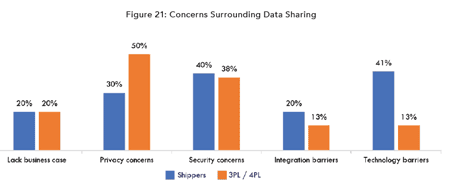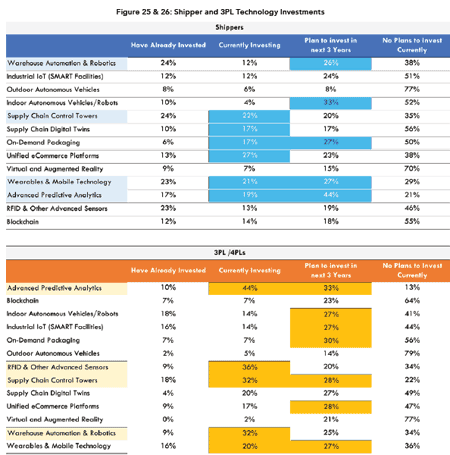State of the 3PL Union 2023 Part 2
Last week, I published my initial review and comment on the 2023/24 3PL Study,ow in its amazing 27th year, all under the leadership of my friend Dr. John Langley of Penn State.
The report was released at the CSCMP Edge conference this Fall in Orlando. (See State of the 3PL Union 2023.)
| GILMORE SAYS: |
WHAT DO YOU SAY?
Many years back, an executive at Procter & Gamble noted to me that there is a cost to every integration, and you need to determine if the ROI is really there from doing it.
Send Us Your Feedback here
|
In my Part 1 review, I focused on the core survey results, which while similar from year to year seems to be being pared back.
That core data included this year just a brief mention of the dreaded "IT Gap," which for many years has found the a large difference between how shippers place 3PL IT capabilities in terms importance (always very high), versus their view of actual 3PL IT capabilities, always with a much lower score.
The IT gap expanded again this year.
As noted last week, the report as usual covers a number of "focus topics" after the review of the core survey data and a discussion of the general state of shipper-3PL relationships.
Let's take a look at a few of them.
These focus topics start with a discussion on "the flow of data" between shippers and 3PLs.
"If the supply chain is the 'engine,' data is the 'oil' that keeps the engine running," the report notes.
There is some "101" stuff here, such as the execution problems that can occur if the shipper doesn't provide accurate carton and item dimensional data to 3PLs.
Just how much data should a shipper provide? That is the question. Many years back, an executive at Procter & Gamble noted to me that there is a cost to every integration, and you need to determine if the ROI is really there from doing it.
The chart below from the report shows the perceived barriers to "data sharing" as perceived by both shippers and 3PLs. As can be seen, data quality tops the list for both shippers and 3PLs - is that still a major problem here in late 2023? Maybe so, but certainly we have made progress, haven't we?

Source: 3PL Study
Of course, the level of integration and data sharing that could/should be pursued for a given shipper and 3PL is driven by the nature of the relationship - strategic, tactical, something in-between. 3PLs naturally usually want to move from a tactical to strategic position.
3PLs it appears are especially interested in getting more/better demand/forecast data. Which begs the question: Why don't more shippers provide this to their 3PLs? They don't have it at the right level for a 3PL? It's not worth the effort to do so? They don't believe the 3PL will really be able to do much with it? Something else?
This is a question the report might look into in next year's survey.
The report next takes a look at "Looking Beyond the Hype of Technology." What does that mean?
Mostly the focus of the report is on the benefits of technology for shippers and 3PLs.
"The No. 1 core competency that shippers are looking for in their 3PLs is marketplace intelligence that can be translated into specific actions that create an advantage for their shipper partner," the report quotes Mark Baxa, CEO of the Council for Supply Chain Management Professionals, as saying.
Baxa adds that "They're looking for digital experience and expertise, pragmatic solutions and critical thinking on a real-time, consistent basis."
The survey found that 94% of 3PLs and 87% of shippers agree that "Emerging technology adoption is critical the future growth and success our company."
There's the "hype" part of the discussion.
The report includes the reasonably interesting chart below, which shows where first shippers and then 3PLs stand on various emerging technologies in terms of investment/adoption.
As a note, I do not understand why the emerging technology list is sequenced differently for shippers versus 3PLs or why there are highlights in some areas on both charts, but it turns out to be worth a look all the same. Full size image at link below the chart.

Souce: 3PL Study
See Full Size Image
Still I question this comment from the report: "3PLs appear to be investing in technology at a slightly higher rate than shippers, with 15% of 3PLs reporting they've already completed investments in emerging technologies compared to 10% of shippers."
First, it's not clear where that referenced data point is coming from. Second, I think it is highly unlikely 3PLs are investing more in emerging technologies than shippers are. Third, given where we are at, what company has "completed" their investment in emerging tech?
There are several more special topics, including reverse logistics, talent management, and "efficiency versus resiliency," but I am going to save them for one more part next week, which will include some concerns I have on the direction of this report.
Any reaction to this data from the 3PL report part 2? Let us know your thoughts at the Feedback section below.
|

